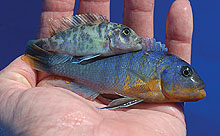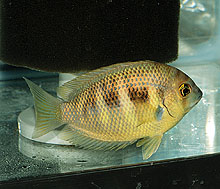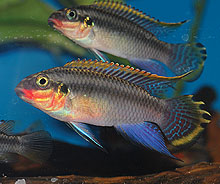Select date in side bar to go to a What's New of previous issues
| What's New
©by Laif DeMason
Since Willem Heijns broached the subject in this issue, let me add my two cents on the wild-caught vs. bred fish discussion. There are pros and cons to each; wild fish generally have wider genetic diversity, breed better, have smaller adult size, and often better color. Bred fish are generally healthier (less disease, parasites), cheaper, and more available to buyers. As both a long time breeder and importer, believe me, I’ve seen plenty of both. For breeders, the strongest attribute of wild fish is the genetic diversity and high offspring production. If you plan to maintain and breed for a wild type “pedigree”, start with at least three pairs (more is better) and be sure each female breeds with each male. Grow out and combine some fry from each spawn, then you can select for the best characteristics that represent that wild type or pedigree. Remember select breeding is not the same as “line-breeding” as line breeding implies a limited genetic line! Here’s “what’s new” on the cichlid scene: |
 Since not all species of the genus Cyprichromis have been described, this has led to confusion between C. leptosoma and C. sp. ‘leptosoma jumbo’. These are TWO different species! They are found in many places around the lake and often together. So there can be two different “Cyps” from the same location. Here the jumbo species from Utinta, Tanzania. Photo by A. Konings. |
 Available in trickles from time to time, lesser known representatives from the genus Limnochromis are occasionally exported. Pictured here, the not often seen L. abeelei from Burundi. This fish can grow quite large and requires large quarters. Breeders have had success housing and breeding the closely related L. auritus in sand substrate tanks containing buried pieces of PVC pipes. |
 Wild caught Malawi predator cichlids always seem to be in demand. Fortunately for those who are keen on these species, December/January is the best time to collect them. Recent collections exports include Buccochromis, Champsochromis, Dimidiochromis, Tyrannochromis, and this fish: Taeniochromis holotaenia from Itungi Port, Tanzania. |
 Various mbuna or rock dwelling cichlids from Malawi, especially those with any OB morph females are currently sought after. This demand has centered on the many varieties from the Metriaclima zebra complex, including M. fainzilberi. Collected from Ikombe, Tanzania, this gold breast M. fainzilberi has unique females of either cream white or OB white morphs. |
 Originally from India, Etroplus canarensis has been bred by hobbyists lately and has attracted some demand for this interesting ancient cichlid form. This cichlid is a substrate spawner that prefers softer water, unlike other species from this genus. |
 One of the original imported “kribensis” types from Nigeria, was, until recently, sold as Pelvicachromis pulcher Nigerian red. Now re-named P. taeniatus, there is still some question as to whether this is a bred strain or not. |